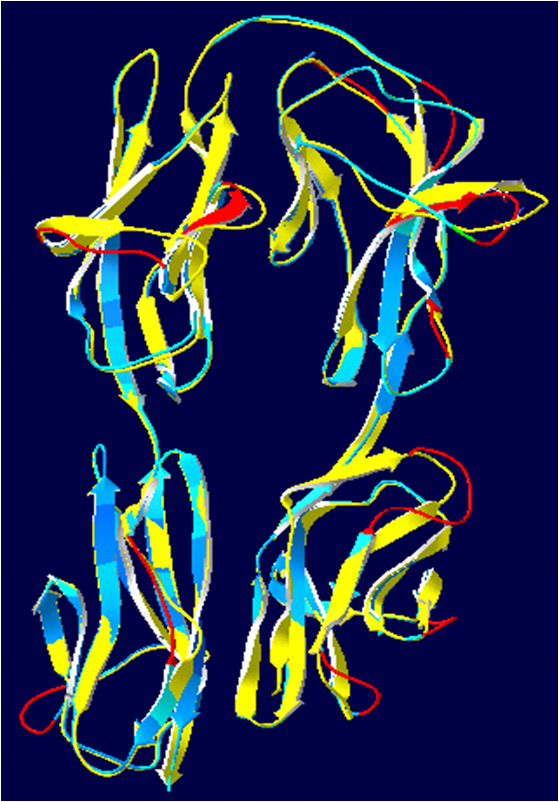Hemolin on:
[Wikipedia]
[Google]
[Amazon]
Hemolin is an  Hemolin increases 18-fold up to 7 mg/ml following injection of bacteria in ''H. cecropia''. Induction of Hemolin in moths after bacterial injection have been shown in several species including ''
Hemolin increases 18-fold up to 7 mg/ml following injection of bacteria in ''H. cecropia''. Induction of Hemolin in moths after bacterial injection have been shown in several species including ''
immunoglobulin
An antibody (Ab) or immunoglobulin (Ig) is a large, Y-shaped protein belonging to the immunoglobulin superfamily which is used by the immune system to identify and neutralize antigens such as pathogenic bacteria, bacteria and viruses, includin ...
-like protein exclusively found in Lepidoptera
Lepidoptera ( ) or lepidopterans is an order (biology), order of winged insects which includes butterflies and moths. About 180,000 species of the Lepidoptera have been described, representing 10% of the total described species of living organ ...
(moths and butterflies). It was first discovered in immune-challenged pupae of ''Hyalophora cecropia
''Hyalophora cecropia'', the cecropia moth, is North America's largest native moth. It is a member of the family Saturniidae, or giant silk moths. Females have been documented with a wingspan of or more. These moths can be found predominately ac ...
'' and ''Manduca sexta
''Manduca sexta'' is a moth of the family Sphingidae present through much of the Americas. The species was first described by Carl Linnaeus in his 1763 ''Centuria Insectorum''.
Commonly known as the Carolina sphinx moth and the tobacco hawk mo ...
''.
Hemolin has a horseshoe crystal structure with four domains and resembles the developmental protein neuroglian.
 Hemolin increases 18-fold up to 7 mg/ml following injection of bacteria in ''H. cecropia''. Induction of Hemolin in moths after bacterial injection have been shown in several species including ''
Hemolin increases 18-fold up to 7 mg/ml following injection of bacteria in ''H. cecropia''. Induction of Hemolin in moths after bacterial injection have been shown in several species including ''Antheraea pernyi
''Antheraea pernyi'', the Chinese oak tussar moth, Chinese tasar moth, or temperate tussar moth, is a large moth in the family Saturniidae. The species was first described by Félix Édouard Guérin-Méneville in 1855. '' Antheraea roylei'' is an ...
'', ''Bombyx mori
''Bombyx mori'', commonly known as the domestic silk moth, is a moth species belonging to the family Bombycidae. It is the closest relative of '' Bombyx mandarina'', the wild silk moth. Silkworms are the larvae of silk moths. The silkworm is of ...
'', ''Helicoverpa zea
''Helicoverpa zea, ''commonly known as the corn earworm, is a species (formerly in the genus ''Heliothis'') in the family Noctuidae. The larva of the moth ''Helicoverpa zea'' is a major agricultural pest (organism), pest. Since it is polyphagous ...
'', ''Heliothis virescens
''Chloridea virescens'', commonly known as the tobacco budworm, is a moth of the family Noctuidae found throughout the eastern and southwestern United States along with parts of Central America and South America.
It is a major pest of field crop ...
'', '' Hyphantria cunea'', and ''Samia cynthia
''Samia cynthia'', the ailanthus silkmoth, is a saturniid moth, used to produce silk fabric but not as domesticated as the silkworm, ''Bombyx mori''. The moth has very large wings of , with a quarter-moon shaped spot on both the upper and lower ...
''.
Hemolin has also been suggested to participate in the immune response to virus infection and shown to bind to virus particles. It is expressed in response to dsRNA
Ribonucleic acid (RNA) is a polymeric molecule that is essential for most biological functions, either by performing the function itself ( non-coding RNA) or by forming a template for the production of proteins ( messenger RNA). RNA and deoxy ...
in a dose-dependent manner. '' Galleria melonella'' responds to caffeine
Caffeine is a central nervous system (CNS) stimulant of the methylxanthine chemical classification, class and is the most commonly consumed Psychoactive drug, psychoactive substance globally. It is mainly used for its eugeroic (wakefulness pr ...
intake by increased Hemolin protein expression.
Hemolin is thought to be a gene duplication of the developmental protein neuroglian, but has lost two of the protein domains that neuroglian contains. In the potential function as a developmental protein, Hemolin has been shown to increase close to pupa
A pupa (; : pupae) is the life stage of some insects undergoing transformation between immature and mature stages. Insects that go through a pupal stage are holometabolous: they go through four distinct stages in their life cycle, the stages th ...
tion in ''Manduca sexta
''Manduca sexta'' is a moth of the family Sphingidae present through much of the Americas. The species was first described by Carl Linnaeus in his 1763 ''Centuria Insectorum''.
Commonly known as the Carolina sphinx moth and the tobacco hawk mo ...
'', and is induced during diapause and by 20-Hydroxyecdysone in ''Lymantria dispar
''Lymantria dispar'', also known as the gypsy moth or the spongy moth, is a species of Lepidoptera, moth in the family Erebidae native to Europe and Asia. ''Lymantria dispar'' is subdivided into several subspecies, with subspecies such as ''Ly ...
''. RNAi
RNA interference (RNAi) is a biological process in which RNA molecules are involved in sequence-specific suppression of gene expression by double-stranded RNA, through translational or transcriptional repression. Historically, RNAi was known b ...
of Hemolin causes malformation in ''H. cecropia''.{{cite journal, last=Bettencourt, first=R., author2=Terenius, O. , author3=Faye, I. , title=Hemolin gene silencing by ds-RNA injected into Cecropia pupae is lethal to next generation embryos, journal=Insect Molecular Biology, date=June 2002, volume=11, issue=3, pages=267–271, doi=10.1046/j.1365-2583.2002.00334.x, pmid=12000646, doi-access=free
See also
* Host defense in invertebratesReferences